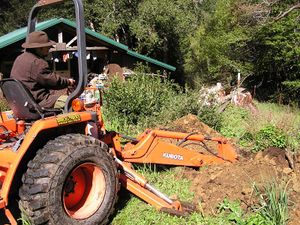| Line 19: | Line 19: | ||
describe in general | describe in general | ||
# First we had to dig a hole deep enough to support the stand. Due to the size of the array this hole had to be five feet deep. We dug the hole with Daniels tractor which is run off bio-diesel. (See Fig | # First we had to dig a hole deep enough to support the stand. Due to the size of the array this hole had to be five feet deep. We dug the hole with Daniels tractor which is run off bio-diesel. (See Fig 1 and 2) | ||
# In the bottom of the hole we laid 6 inches of gravel. This gravel is to allow for the drainage of any water that might find its way into the post. | # In the bottom of the hole we laid 6 inches of gravel. This gravel is to allow for the drainage of any water that might find its way into the post. | ||
# | # Once the gravel was down we put in the concrete form. This consisted of a ½ inch thick cardboard tube that is 16 inches in diameter. (see Fig 4) | ||
# | # After the form was in we centered the stand with in it. The stand is a steel ½ inch, 16 inch diameter post. The post was to heavy for us to lift and move around once it was in the hole so we tied it to the tractor to lifted it up while I centered it and then lowered it back down. (see Fig 5 and 6) | ||
# | # When the stand was in place it was time to pour the concrete. We used a mixer which was run off the electricity from a micro-hydro system we installed in the fall. This made the job go a lot quicker then if we had to mix all the bags by hand. In total we used 10 bags of quick-crete. When done it is important to make sure that the concrete is not level but raised up some. This is because it will shrink and settle down as it drys. (see Fig 7 and 8) | ||
[[Image:BricelandHole.jpg|thumb|left|Digging hole]] | [[Image:BricelandHole.jpg|thumb|left|Digging hole]] | ||
<gallery> | <gallery> | ||
Image:BricelandHole.jpg|Digging hole. I wonder how much test will still look good in this caption? Let's see what this looks like with word wrap. | Image:BricelandHole.jpg|Fig 1: Digging hole. I wonder how much test will still look good in this caption? Let's see what this looks like with word wrap. | ||
Image:Digging hole -2.jpg | Image:Digging hole -2.jpg|Fig 2: | ||
Image:Checking hole depth.jpg | Image:Checking hole depth.jpg|Fig 3: | ||
Image:Concrete Form.jpg | Image:Concrete Form.jpg|Fig 4: | ||
Image:Setting the stand.jpg | Image:Setting the stand.jpg|Fig 5: | ||
Image:The stand.jpg | Image:The stand.jpg|Fig 6: | ||
Image:Pouring concrete.jpg | Image:Pouring concrete.jpg|Fig 7: | ||
Image:Finishing the concrete.jpg | Image:Finishing the concrete.jpg|Fig 8: | ||
</gallery> | </gallery> | ||
Revision as of 03:33, 29 April 2006
Introduction
This project is a solar blah blah blah.
PV Array
describe array and components.
- Panel
- Mount
- Roof
- Inverter
Wiring
describe wiring... maybe some photos,, yada yada.
Construction
describe in general
- First we had to dig a hole deep enough to support the stand. Due to the size of the array this hole had to be five feet deep. We dug the hole with Daniels tractor which is run off bio-diesel. (See Fig 1 and 2)
- In the bottom of the hole we laid 6 inches of gravel. This gravel is to allow for the drainage of any water that might find its way into the post.
- Once the gravel was down we put in the concrete form. This consisted of a ½ inch thick cardboard tube that is 16 inches in diameter. (see Fig 4)
- After the form was in we centered the stand with in it. The stand is a steel ½ inch, 16 inch diameter post. The post was to heavy for us to lift and move around once it was in the hole so we tied it to the tractor to lifted it up while I centered it and then lowered it back down. (see Fig 5 and 6)
- When the stand was in place it was time to pour the concrete. We used a mixer which was run off the electricity from a micro-hydro system we installed in the fall. This made the job go a lot quicker then if we had to mix all the bags by hand. In total we used 10 bags of quick-crete. When done it is important to make sure that the concrete is not level but raised up some. This is because it will shrink and settle down as it drys. (see Fig 7 and 8)

-
Fig 1: Digging hole. I wonder how much test will still look good in this caption? Let's see what this looks like with word wrap.
-
Fig 2:
-
Fig 3:
-
Fig 4:
-
Fig 5:
-
Fig 6:
-
Fig 7:
-
Fig 8:







